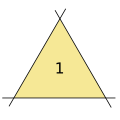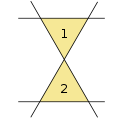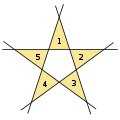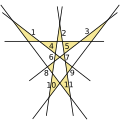Kobon triangles
Kobon triangles are triangles that are created by drawing multiple lines. The corresponding Kobon triangle problem is the question of how many non-overlapping triangles can be generated at most if you draw straight lines in the plane. The namesake Kobon Fujimura , a Japanese math teacher and puzzle author, published the task in his 1978 book "The Tokyo Puzzle".
Solutions to the problem result from the consideration of straight lines in the projective plane , whereby only affine triangles are counted.
Kobon number
For up to six straight lines, it is easy to try and find arrangements that create as many triangles as possible. While only a triangle can be formed with three straight lines, there are a maximum of 2, 5 and 7 for four, five and six straight lines.
How many triangles can be generated for any number of straight lines (the so-called Kobon number) is a hitherto unsolved problem of combinatorial geometry , the solution of which is assumed to be very difficult.
Upper bound
The following proof by Saburo Tamura makes it possible to determine an upper bound of the Kobon number for a given . Each of the straight lines intersects the remaining lines at most once. The intersection points form line segments ( fence post problem ), so the figure has a maximum of segments (in the example shown above, segments were created , for example ). Every free-standing triangle now needs exactly three of these line segments, unless it shares one or more edges with another triangle (in the example ). In these cases, however, three straight lines must intersect in one point for every two triangles, which reduces the number of line segments by three - more than the two saved line segments.
So every triangle needs (at least) three segments. This is
an upper bound for the maximum number of non-overlapping triangles made of straight lines.
However, the limit is not always reached. A maximum of triangles - one triangle less than the upper bound - can be formed with straight lines . This can be explained with further considerations, from which the narrower upper bound
by Clément and Bader. denotes the characteristic function .
Recursive procedure
D. Forge and JL Ramirez Alfonsin have shown that there are arrangements for an infinite number of values which reach the upper bound of Tamura. The proof contains a recursive procedure with which for a perfect solution with straight lines - a solution which reaches the maximum number of triangles - further perfect arrangements with straight lines can be calculated. For example, the perfect solutions for etc. can be determined from the solution for 3 lines .
Well-known solutions
Perfect solutions, i.e. Kobon triangles that reach the upper bound, are known for. Except for these , the maximum number of triangles is not known. For and the best known solution contains one triangle less than the upper bound, for and two triangles less.
The following listing shows the upper bound as well as the best known solution for various .
| k | 3 | 4th | 5 | 6th | 7th | 8th | 9 | 10 | 11 | 12 | 13 | 14th | 15th | 16 | 17th | 18th | 19th | 20th | 21st | ... |
|---|---|---|---|---|---|---|---|---|---|---|---|---|---|---|---|---|---|---|---|---|
| Upper bound for N ( k ) | 1 | 2 | 5 | 7th | 11 | 15th | 21st | 26th | 33 | 40 | 47 | 55 | 65 | 74 | 85 | 95 | 107 | 119 | 133 | ... |
| Best known solution | 1 | 2 | 5 | 7th | 11 | 15th | 21st | 25th | 32 | 38 | 47 | 53 | 65 | 72 | 85 | 93 | 104 | 115 | 130 | ... |
The well-known Kobon triangular numbers are printed in bold. They are the sequence A006066 in OEIS .
Web links
Individual evidence
- ^ Kobon Triangle at Mathworld .
- ^ A b Column by Ed Pegg Jr. on Math Games.
- ↑ a b Various solutions and evidence for the upper bound ( memento of the original from March 3, 2016 in the Internet Archive ) Info: The archive link was automatically inserted and not yet checked. Please check the original and archive link according to the instructions and then remove this notice.
- ^ "Straight line arrangements in the real projective plane" , D. Forge and JL Ramirez Alfonsin, Discrete and Computational Geometry, Volume 20, Number 2, Pages 155-161, 1998.
- ↑ "Matlab Code, which shows the method of D. Forge and JL Ramirez Alfonsin"



























